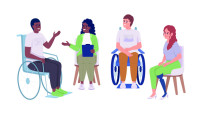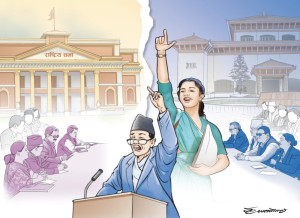Columns
The question of AI in students’ writing
Students shouldn’t lose their originality by entirely depending on AI as it cannot think independently.
Gehendra Koirala
Artificial intelligence is the product of an unbounded craving for automation. Since the beginning of human civilisation, we have been inventing new machines and technologies to reduce our physical and mental efforts to accomplish tasks. The fascination with automatic intelligent thinking machines that can function as human brains have shaped the narratives of different eras of human history, coloured the imagination of scientists of different epochs and constructed the plots of science fiction.
According to reports, those scientists and philosophers who described the process of human thinking as the mechanical manipulation of symbols were the first to plant the seeds of AI. The invention of programmable digital computers in the 1940s and the use of mathematical reasoning in their functioning made some scientists hopeful towards building electronic brains. For this purpose, AI research was founded at a workshop held at Dartmouth College in 1956, where John McCarthy, an American computer scientist and cognitive scientist, introduced the term “artificial intelligence”.
After countless experiments and many failures, scientists have created several forms of AI for different objectives. However, the advancement of large language models (LLMs) like ChatGPT in writing or composition has ignited widespread debate over their legitimacy, morality and suitability. Since its inception on November 30, 2022, ChatGPT’s use has drawn the attention of many theorists and scholars of writing pedagogy as it is now regarded as a thinking machine that can generate human-like texts. This intelligent machine can change traditional pedagogical practices by transforming the writing process, including students’ approach towards writing assignments. Some theorists think that these tools can negatively affect the writing process, while others believe that they can be used as reliable tools to move to different stages of the writing process.
Positive uses of AI
These days, student writers have access to various AI tools with diverse functions that help them go through different stages of the writing process. Grammarly is an editing tool that checks grammar, spelling, punctuation and style and gives required suggestions for further improvements. Quillbot can be used for paraphrasing; Snazzy AI for content creation; Sribbr Plagiarism Checker for detecting intellectual theft and ensuring originality. Among these tools, ChatGPT is regarded as the smartest and most powerful electronic thinking brain due to its ability to navigate corpus texts and produce human-like texts. Undoubtedly, AI’s prudent and creative application can assist student writers in the writing process, to which even pundits of composition pedagogy agree.
For example, Generative AI manipulates the process of machine learning to generate results from the existing online corpus data by detecting recurring patterns. Gen AIs like ChatGPT can instantly work on user prompts and create desired texts. Even in academic settings, the likelihood of using diverse writing-related AI tools by students cannot be denied. This means that the future of writing or composition will be shaped by the invasion of AIs into these territories. So, we must use AIs creatively, honestly and wisely in education to maintain academic aura and integrity. This can bring opportunities for positive changes in education, particularly in teachers’ and students’ academic performance in writing and other activities.
Negative impacts
Despite the merits of AI in the writing process, they are not without flaws. The latest version of ChatGPT, which has become more powerful and creative in generating diverse texts, has made compositionists anxious about its consequences. They believe such tools may cause adverse effects on the overall writing process. They have detected serious flaws in AI-generated writing and are also concerned about the future of teaching writing and the possible misuse of AI by student writers.
Opponents of AI have pointed out some drawbacks to the unrestricted and unchecked use of writing tools. First, AI tools lack the human creativity or cognition to differentiate bad content from good ones. There are also issues pertinent to the violation of copyright and plagiarism in writing.
Moreover, large language models have been encoded in linguistic patterns of the so-called dominant language, English, which may give birth to a new form of colonialism and undermine the spirit of social justice for which minorities have been fighting for generations. The concept of linguistic inclusiveness in composition pedagogy and translanguaging (how bilinguals and multilinguals utilise their language skills to understand and engage with their environment) will likely be affected. Additionally, AI lacks humans’ crystallised intelligence/knowledge, contextual understanding and syntactical innovation and cannot be involved in meaning-making.
Furthermore, AI cannot detect biases and discriminatory content found in their source data. AI-generated texts can cross all the boundaries of propriety, linguistic justice and social inclusiveness by creating unreadable and unacceptable texts. These contents are also just imitations, which can be repetitive and factually incorrect. In short, AI cannot work independently in expected ways. Human intervention and creativity are required to check them constantly.
To bridge the divided perspectives and achieve a balance, student writers need to mitigate the negative aspects of AI-generated texts to save their composition, ingenuity and authenticity. They should use these tools as one relies on co-authors to assist with pre-and post-writing activities such as idea generation, editing and proofreading. Students should understand that depending entirely on AI will not be beneficial in the long run. After all, these tools aren’t independent thinkers and cannot replace our originality and empirical knowledge.




 17.91°C Kathmandu
17.91°C Kathmandu















